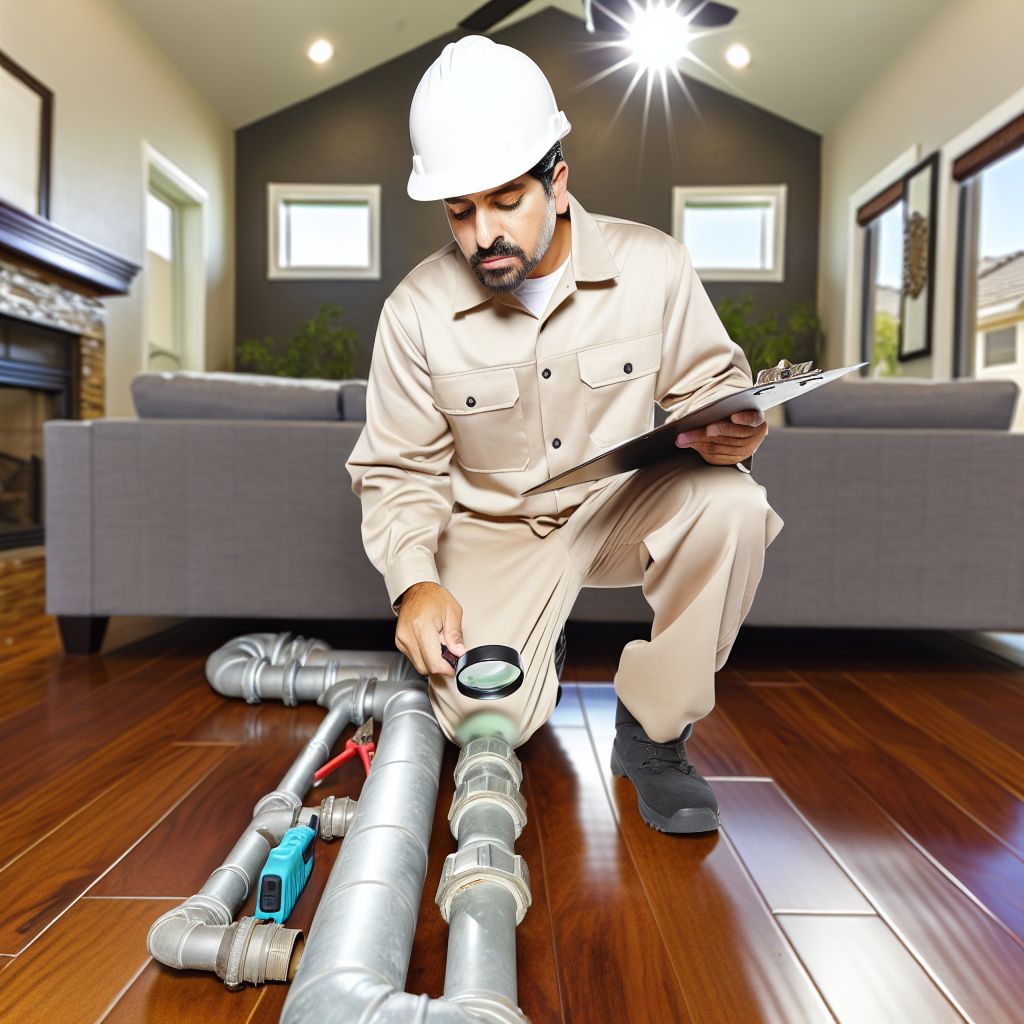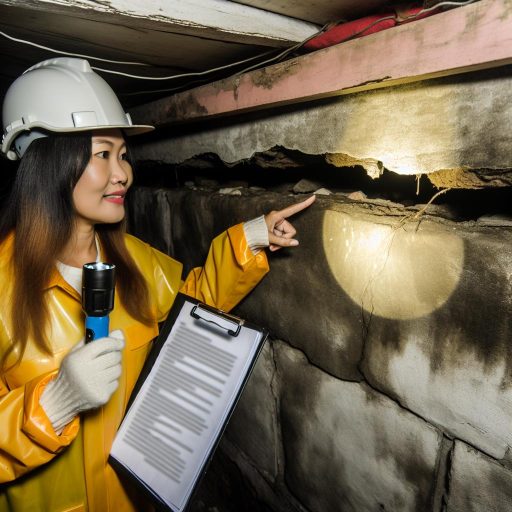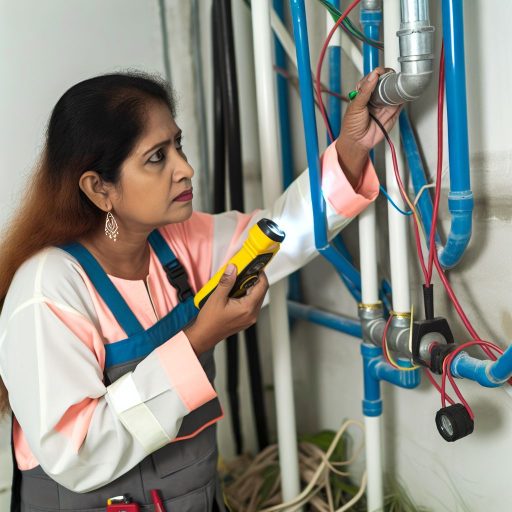Introduction to Home Inspection and Its Importance
Home inspection is a critical process for potential buyers and current homeowners.
This practice assesses the condition of a home before a purchase or renovation.
It includes examining the plumbing, roofing, foundation, and electrical systems.
Particularly, plumbing systems play a significant role in overall home functionality.
Understanding plumbing issues can save significant costs in repairs later.
Moreover, a thorough plumbing inspection promotes safety and health standards.
It helps identify leaks that may cause mold and other hazardous conditions.
The inspection process also informs buyers about necessary maintenance tasks.
Consequently, knowing the condition of plumbing systems influences negotiation power.
Ultimately, a proper home inspection provides peace of mind for homeowners.
In short, plumbing evaluations are essential to making informed real estate decisions.
Overview of Plumbing Systems in Residential Properties
Understanding Plumbing Systems
Plumbing systems are essential for residential properties.
They deliver clean water and remove waste efficiently.
These systems include various components like pipes, fixtures, and appliances.
Major Components of Plumbing Systems
The plumbing system has several key components.
- Pipes transport water throughout the home.
- Fixtures include sinks, toilets, and faucets.
- Water heaters supply hot water for various needs.
- Sewage systems manage wastewater effectively.
Types of Plumbing Systems
There are two primary types of plumbing systems.
The water supply system brings fresh water into the home.
The drainage system removes wastewater and sewage.
Materials Used in Plumbing
Various materials are used in plumbing installations.
- Copper pipes are durable and resist corrosion.
- PVC pipes are lightweight and easy to install.
- PEX is flexible and suitable for many applications.
Importance of Regular Plumbing Maintenance
Regular maintenance is crucial for plumbing systems.
It helps prevent leaks and costly repairs.
Homeowners should schedule inspections periodically.
This practice ensures the system operates efficiently.
Key Components of Plumbing Systems to Inspect
Pipes
Pipes serve as the core of residential plumbing systems.
Inspect both supply and drain pipes for any signs of wear.
Check for corrosion, leaks, and any unusual noises.
PVC, copper, and galvanized steel are common materials in use.
Fixtures
Fixtures include sinks, toilets, and bathtubs.
Check for leaks around faucet bases and connections.
Examine toilets for proper flushing mechanisms and leaks.
Ensure that bathtub drains are functioning correctly.
Water Heaters
Water heaters provide hot water for various household needs.
Inspect the unit for rust, leaks, or unusual noises.
Check the temperature settings and ensure they are safe.
Verify that the pressure relief valve is operational.
Drains
Proper drainage is crucial for preventing water damage.
Test all drains for clogs or slow drainage issues.
Inspect visible parts of the drainage system for corrosion.
Check that drain covers are secure and in good condition.
Sump Pumps
Sump pumps help prevent flooding in basements.
Check the pump for operational integrity and wear.
Inspect the discharge line for clogs or leaks.
Test the system by pouring water into the sump pit.
Valves
Valves control the flow of water in your plumbing system.
Check all shut-off valves for functionality.
Inspect the condition of pipe fittings and connections.
Ensure that valves close tightly to prevent leaks.
Uncover the Details: Home Inspection Checklist For Identifying Electrical Problems
Step-by-Step Guide for Conducting a Plumbing Inspection
Preparing for the Inspection
Start by gathering necessary tools for the inspection.
You will need a flashlight, pliers, and a wrench.
Next, review the property’s history to identify potential problem areas.
Compile a checklist to stay organized during your evaluation.
Inspecting the Interior Plumbing
Begin by checking the kitchen and bathroom faucets.
Look for signs of leaks or water damage under the sink.
Turn on each faucet and observe the water pressure.
Inspect the exposed pipes for corrosion or wear.
Ensure the valves are functioning and not stuck.
Test the toilets by flushing and checking for leaks.
Evaluating the Water Heating System
Examine the water heater for its age and condition.
Check for signs of leakage around the unit.
Inspect the temperature and pressure relief valve.
Ensure the heater is adequately vented to prevent gas buildup.
Assess the insulation and energy efficiency of the unit.
Assessing the Drainage System
Inspect all visible drainage pipes for blockages.
Check for slow drains in sinks and bathtubs.
Examine the sewer cleanout for accessibility.
Test the drainage by running water and observing flow.
Look for any foul odors indicating possible issues.
Reviewing Outdoor Plumbing
Inspect outdoor faucets and hoses for leaks or damage.
Check the irrigation system and any exposed pipes.
Look for proper drainage away from the foundation.
Ensure outdoor water features are functioning properly.
Documenting Your Findings
Take notes on any issues identified during the inspection.
Photograph problem areas for reference.
Summarize your findings with recommendations for repairs.
Share the report with homeowners for transparency.
Find Out More: How To Save For A Down Payment As A First-Time Homebuyer In The USA
Identifying Common Plumbing Issues
Visible Signs of Leaks
Look for water stains on ceilings and walls.
Examine the floors for unevenness or dampness.
Visible mold growth indicates a moisture problem.
Check under sinks for pooling water or corrosion.
Unusual Sounds
Listen for dripping sounds from faucets or pipes.
Clanking noises may signal loose pipes.
Gurgling sounds from drains can indicate clogs.
Drainage Issues
Notice if water drains slowly from sinks or tubs.
Standing water in the yard may indicate a sewer line issue.
Frequent backups in toilets suggest serious problems.
Water Pressure Problems
Test the water flow from faucets and showerheads.
Inconsistent pressure may indicate hidden leaks.
Low pressure can result from mineral buildup in pipes.
Odors and Smells
Unpleasant odors can indicate sewage problems.
Plumbing drains should not emit strong smells.
Pungent smells from garbage disposals require immediate attention.
Pest Infestations
Check for signs of insects or rodents near plumbing fixtures.
Pests might enter through cracks in pipes or walls.
Infestations can signal underlying plumbing issues.
Learn More: Steps To Qualify For A Home Loan As A First-Time Homebuyer In The USA
Tools and Equipment Required for Plumbing Inspections
Essential Tools
A variety of essential tools are needed for plumbing inspections.
These tools help ensure a thorough evaluation.
- A pipe wrench is crucial for tightening and loosening fittings.
- A basin wrench reaches difficult spots under sinks.
- A tape measure is necessary for measuring pipe lengths and clearances.
- A flashlight illuminates dark spaces for better visibility.
- A plunger assists in checking for clogs in drains.
Equipment for Detection
Specialized equipment aids in detecting plumbing issues.
Investing in quality detection tools can save time and effort.
- A thermal camera detects leaks and temperature changes.
- A moisture meter measures moisture levels in walls and floors.
- A sewer camera inspects underground pipes for blockages.
Safety Gear
Safety should always be a priority during inspections.
Wearing proper safety gear protects against injuries.
- Gloves prevent cuts and skin contact with harmful materials.
- Safety goggles shield eyes from debris and chemicals.
- Steel-toed boots protect feet from heavy tools and materials.
Documentation Tools
Proper documentation streamlines the inspection process.
Using notebooks or mobile devices helps keep track of findings.
- A checklist ensures all areas are inspected thoroughly.
- Digital cameras record visual evidence of issues.
- Software applications assist in generating reports easily.
By gathering the right tools and equipment, inspectors can effectively assess plumbing systems.
This preparation enhances the quality and accuracy of the inspection process.
Gain More Insights: How to Secure the Best Mortgage for Your Financial Situation

Understanding Local Building Codes and Standards for Plumbing
Importance of Local Building Codes
Local building codes ensure plumbing systems are safe and efficient.
These regulations protect both homeowners and the environment.
Additionally, they outline the minimum safety standards for installations.
Common Plumbing Regulations
Many local codes address specific requirements for materials used.
For example, certain pipes must withstand specific pressure ratings.
Moreover, codes often dictate the sizing for plumbing fixtures.
Permits and Inspections
Homeowners typically need permits for significant plumbing work.
Municipalities conduct inspections to verify compliance with local codes.
Inspections help identify potential issues before they escalate.
Staying Updated with Changes
Building codes may change due to advancements in technology.
It is crucial for homeowners to stay informed about these updates.
Local building departments often provide resources for this purpose.
Engaging with Professionals
Hiring certified plumbers ensures compliance with local codes.
Experienced professionals are familiar with regulations in your area.
They can guide you through the necessary permit processes.
Documenting Findings: Creating a Plumbing Inspection Report
Importance of a Plumbing Inspection Report
A plumbing inspection report is essential for documenting findings.
It provides a detailed overview of the plumbing system’s condition.
Furthermore, it helps homeowners make informed decisions.
Key Components of the Report
Begin with basic information about the property.
Include the property address and inspection date.
Document the names of the inspector and homeowner.
Next, focus on the plumbing system’s components.
Break down findings into sections such as fixtures, pipes, and drains.
Using Clear and Concise Language
Clarity is crucial in plumbing inspection reports.
Use straightforward language to describe issues.
Avoid technical jargon unless necessary.
This ensures the report is understandable to everyone.
Visual Aids and Photos
Include photos to illustrate specific problems.
Visuals can enhance understanding of the findings.
Furthermore, they provide evidence to support your observations.
Prioritizing Issues and Recommendations
Highlight any urgent issues that require immediate attention.
Clearly categorize problems based on severity.
Additionally, provide recommendations for repairs or further evaluations.
This guidance can help homeowners address issues promptly.
Follow-Up Actions
Suggest next steps for the homeowner.
This may include contacting a licensed plumber for repairs.
Moreover, encourage regular maintenance to prevent future problems.
Maintaining records of inspections can be beneficial.
Best Practices for Homeowners After Inspection
Understanding Your Plumbing System
Know the key components of your plumbing system.
This includes pipes, fixtures, and appliances.
Familiarize yourself with the layout of your home’s plumbing.
Identify potential trouble spots for easier maintenance.
Routine Maintenance Checks
Schedule regular inspections to assess the plumbing condition.
Check for leaks around fixtures and under sinks.
Inspect showerheads and faucets for mineral build-up.
Additionally, monitor water pressure for irregularities.
Immediate Repairs
Address minor leaks promptly to prevent larger issues.
Replace worn seals and gaskets to avoid water waste.
Tighten loose fittings on hoses and connections.
Drain Care and Maintenance
Use strainers to catch debris and prevent clogs.
Regularly clean drains with hot water to maintain flow.
Avoid flushing inappropriate items down toilets.
Maintenance Tips
Seasonal Plumbing Checks
Inspect outdoor plumbing systems before winter.
Disconnect hoses and drain outdoor faucets to prevent freezing.
During spring, check for any damage caused by winter weather.
Water Quality Testing
Test your water for lead, bacteria, and hardness.
Use home testing kits for convenience.
Consider installing water filters for improved quality.
Hiring Professionals When Necessary
Know when to consult a plumber for complex issues.
Seek experienced professionals for more extensive repairs.
Review references and check credentials before hiring.
Additional Resources
If you’re buying an older home, is it worth having a house inspection …
Home Inspection Checklist: What Do Home Inspectors Look For …




